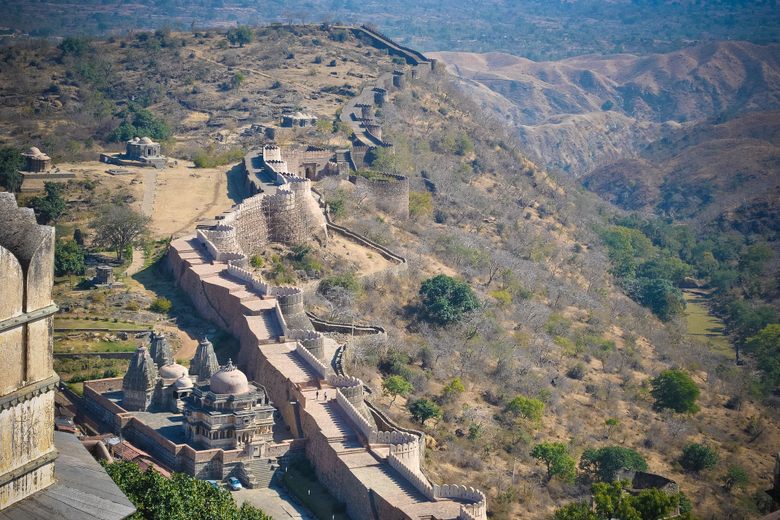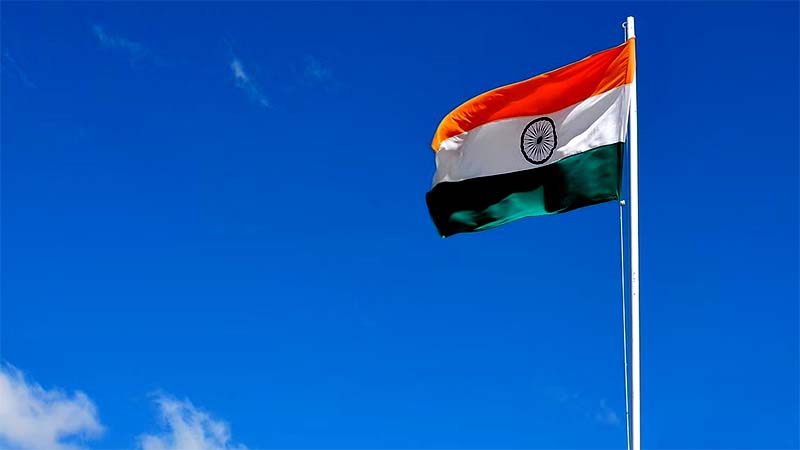Kumbhalgarh (meaning “Kumbhal fort”), popularly known as the Great Wall of India, is a Mewar fortification on the western slope of the Aravalli Hills in Rajasthan’s Rajsamand district near Udaipur. After China’s Great Wall and Iran’s Great Wall of Gorgan, it is the world’s third-longest wall. It is a UNESCO World Heritage Site that is part of Rajasthan’s Hill Forts. Rana Kumbha constructed it in the 15th century.

Kumbhalgarh Fort, together with five other forts in Rajasthan, was named a UNESCO World Heritage Site under the category Hill Forts of Rajasthan in 2013, at the 37th session of the World Heritage Committee in Phnom Penh, Cambodia.
Mandan, the fort’s primary architect, documented his method of construction in his book Rajvallabh. The fort is one of the world’s largest fortifications.
Background
Due to a lack of evidence, the fort’s early history could not be determined. Prior to Rana Kumbha’s construction of the new fort, there was a small fort known as Matsyaendra Durg that was thought to have been built by King Samprati of the Maurya and was limited to a small mountainous region. In the late 14th century, Rana Lakha defeated the Chauhan Rajputs of Nadol and took control of the entire territory as well as the Godwar plains.
Rana Kumbha, the Rana of Mewar from the Sisodia rajput clan, built Kumbhalgarh as the fort we see today. Rana Kumbha enlisted the help of “Mandan,” a well-known architect of the time. Rana Kumbha’s Mewar dominion spanned from Ranthambore to Gwalior, encompassing huge swaths of modern-day Madhya Pradesh and Rajasthan. Rana Kumbha is reported to have constructed 32 forts in his realm, the greatest and most elaborate of which is Kumbhalgarh.
Kumbhalgarh also served as a buffer between Mewar and Marwar, and as a safe haven for Mewar’s rulers in times of danger. In 1535, while Chittor was under siege, Prince Udai, the baby king of Mewar, was smuggled here. Later, Prince Udai succeeded to the throne. Direct assaults failed to penetrate the fort.
Gujarat’s Ahmed Shah I attempted an attack on the fort in 1457, but was unsuccessful. The Banmata deity in the fort was thought to defend it at the time, therefore he destroyed the temple. Mahmud Khalji made two more attempts in 1458–59 and 1467, but they were also unsuccessful. Shahbaz Khan, Akbar’s general, stormed the fort in October 1577, and after a six-month siege, he was able to seize it in April 1577. However, Pratap recovered it in 1578. An armed band of sanyasis created a garrison to hold the fort in 1818, but James Tod persuaded them to surrender, and the fort was taken over by the British and eventually returned to the state of Udaipur. Maharanas of Mewar added to the edifice, but Maharana Kumbha’s original structure still stands. Residential structures and temples have been carefully conserved. Maharana Pratap is said to have been born at the fort.
Important Structures
Built on a mountaintop 1,100 metres (3,600 feet) above sea level in the Aravalli range, the fort of Kumbhalgarh boasts 36 km (22 km) of perimeter walls, making it one of the world’s longest. The walls on the front are fifteen feet thick. There are seven fortified entrances in Kumbhalgarh. Within the fort, there are around 70 temples, both Jain and Hindu. The Aravalli Range may be seen for kilometres from the top of the palace.
The fort’s first access gate was Aaret Pol. The entrance to Halla Pol is on a descending slope. Badshahi Bavdi is a tiered tank created during the invasion of Shahbaz Khan, the Mughal emperor Akbar’s general, in 1578 to furnish water to the troops.
The next gate, Hanuman Pol, is half a kilometre away from Halla Pol. Hanuman Pol is a two-story gate with eight-sided bastions. The stone picture of Hanuman in front of the gate, which was delivered by Maharana Kumbha, gave the gate its name.
The primary entrance to the fort is Ram Pol, however there is another entrance to the east, Vijay Pol. Between Ram Pol and Badal Mahal, the Palace built on the fort’s highest point, there are five further gates. Bhairon Pol, Nimboo Pol, Chaugan Pol, Pagda Pol, and Ganesh Pol are the names of the gates. The Ram Pol, which is considered an architectural specimen, provides views of the majority of the buildings.
Hindu Temple
- Ganesha temple: Situated on the left of the Ram Pol, this temple was built by Maharana Kumbha and the image of Ganesha is enshrined in the sanctum. Standing on a high platform entered through a flight of steps from the south. The sanctum has decorated curvilinear brick sikhar while mandapa and mukhamandapa have a domical ceiling.
- Charbhuja temple: Dedicated to the four-armed goddess, this temple is just on the hill slope on the right side of Ganesha Temple. It is raised over a high platform and enclosed by a wall with an entrance from the east.
- Neel Kanth Mahadeva temple is located on the eastern side of the fort built during 1458 CE. The central shrine of Shiva is approached through a rectangular enclosure and through a structure supported by 24 huge pillars. The idol of Shiva is made of black stone and is depicted with 12 hands. The inscriptions indicate that the temple was renovated by Rana Sanga.
- Mataji temple, also called Kheda Devi temple is located on the southern side of Neela Kanth temple.
- There are 5 Hindu temples in Golera group of temples: Mamadeo temple. Cenotaph of Kunwar Prithviraj, elder brother of Rana Sanga is near to this temple.
- Surya Mandir (Sun temple)
Jain Temple
- Parsva Natha temple (built during 1513), Jain temple on the eastern side and Bawan (52) Jain temples.
- There are 4 Jain Temples in the Golera group of temples.
- 2 Jain Temples near Vijay Pol
- Juna Bhilwara Temple
- Pital Shah Jain temple
In Popular Cultures
In honour of Maharana Kumbha’s passion for art and architecture, the Rajasthan Tourism Department hosts a three-day yearly festival in the fort. The fort serves as the backdrop for sound and light shows. Several concerts and dance events will be held to honour the occasion. Heritage Fort Walk, turban tying, tug-of-war, and mehendi mandana are among the festival’s other activities.
Amber Fort, Chittor Fort, Gagron Fort, Jaisalmer Fort, Kumbhalgarh Fort, and Ranthambore Fort were all added to the UNESCO World Heritage Site list during the 37th World Heritage Committee conference in Phnom Penh in June 2013. They were identified as a series of cultural properties and Rajput military hill architecture.
